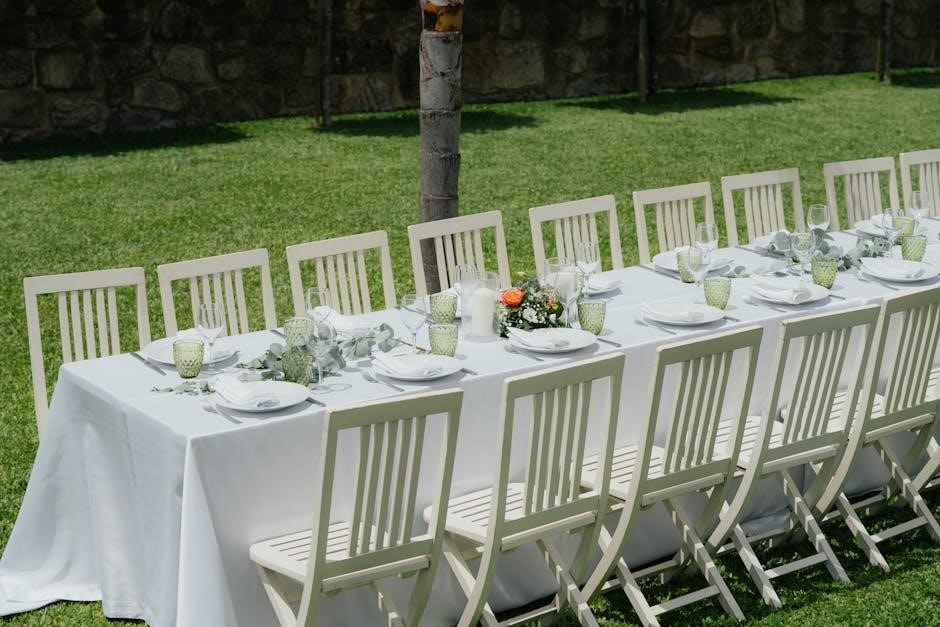Planning a celebration of life is a meaningful way to honor the deceased, focusing on their life and legacy while bringing comfort and closure to loved ones. Using a guide ensures a personalized and memorable tribute successfully.
1.1 Understanding the Concept of a Celebration of Life
A celebration of life is a meaningful event honoring the deceased, focusing on their life, achievements, and impact on others. Unlike traditional funerals, it emphasizes joy and reflection, celebrating the person’s legacy. This personalized tribute allows loved ones to share memories and find comfort. It can include decorations, music, and stories, making it a unique way to commemorate their life. The event’s tone is often uplifting, reflecting the individual’s personality and experiences. It serves as a healing process for those grieving, providing closure and a chance to celebrate the life lived; Understanding this concept helps families create a memorable and heartfelt tribute.
1.2 Importance of Planning a Meaningful Celebration
Planning a meaningful celebration of life is crucial for honoring the deceased and supporting the grieving process. It provides an opportunity to reflect on the person’s life, share memories, and find closure. A well-planned celebration ensures that the event is personalized, capturing the individual’s personality and legacy. It also alleviates stress for loved ones by offering a structured way to navigate their emotions. By focusing on meaningful elements, such as stories, music, and rituals, the celebration becomes a therapeutic experience. Proper planning ensures that the event is both memorable and respectful, creating a lasting tribute that resonates with all attendees. This thoughtful approach helps families and friends heal while celebrating the life of their loved one.

Step-by-Step Celebration of Life Planning
Plan a meaningful celebration by setting a budget, choosing a date, selecting a venue, and deciding on a theme. Ensure a smooth process with clear steps.
2.1 Setting a Budget for the Celebration
Setting a budget is crucial to ensure the celebration aligns with your financial capacity while honoring your loved one. Start by estimating costs for venue, catering, decorations, and entertainment. Allocate funds based on priorities, such as music or personalized elements. Average costs vary widely, so research local prices to create an accurate plan. Consider optional expenses like a slideshow or memory book. Stick to your budget to avoid overspending, and seek cost-saving tips from guides or checklists. A well-planned budget ensures a meaningful celebration without financial strain, allowing you to focus on celebrating their life rather than stressing over expenses.
2.2 Choosing a Date for the Celebration
Choosing a date for the celebration of life is a critical step to ensure loved ones can attend and honor the deceased. Consider scheduling the event within a week or two of passing, if possible, to allow guests time to make arrangements. Weekends are often ideal for better attendance, while weekdays may be more convenient for local family and friends. Avoid major holidays or special events that could conflict with attendance. Ensure enough time for proper planning and coordination with vendors. Weather and seasonal preferences should also be considered, especially for outdoor events. A well-chosen date balances convenience, comfort, and respect for the deceased’s memory, ensuring a meaningful gathering for all.
2.3 Selecting a Venue for the Celebration
Selecting a venue for the celebration of life is a crucial decision that sets the tone for the event. Choose a location that reflects the personality or preferences of the deceased, such as a church, garden, or community center. Ensure the venue can accommodate the expected number of guests comfortably, with options for seating and standing. Consider the accessibility of the location for elderly or disabled attendees. Weather and seasonal factors should also influence your choice, especially for outdoor venues. Budget constraints may limit options, so compare costs and services offered by different venues. Ultimately, the venue should provide a meaningful and fitting space to honor the life being celebrated, ensuring a memorable experience for all attendees.
2.4 Deciding on a Theme or Tone for the Celebration
Deciding on a theme or tone for the celebration of life personalizes the event and reflects the deceased’s personality. Consider their hobbies, interests, or lifestyle to inspire the theme, such as a military, floral, or vintage motif. The tone can range from somber and reflective to joyful and celebratory, depending on the family’s preferences. Incorporate elements like music, decorations, and attire that align with the chosen theme. For instance, a casual gathering might feature vibrant colors and upbeat music, while a formal event could emphasize elegance and tradition. The theme should create a cohesive and meaningful atmosphere, ensuring the celebration is a fitting tribute to the life being honored.
Personalizing the Celebration
Personalizing the celebration involves incorporating meaningful elements like personal stories, decorations, music, and mementos to reflect the deceased’s life and personality, creating a heartfelt tribute.

3.1 Incorporating Personal Stories and Memories
Incorporating personal stories and memories into the celebration of life adds depth and authenticity, allowing guests to connect with the deceased’s journey and legacy. Sharing anecdotes about their achievements, hobbies, and cherished moments creates a heartfelt tribute. Encourage family and friends to contribute, ensuring a diverse collection of memories. Displaying these stories through speeches, written notes, or visual presentations enriches the event. This approach transforms the celebration into a meaningful reflection of the person’s life, offering comfort and closure to all who attend.
3.2 Choosing Decorations and Ambiance
Choosing the right decorations and ambiance is crucial for creating a heartfelt celebration of life. Start by selecting elements that reflect the deceased’s personality, such as their favorite colors, flowers, or meaningful objects. Personal items like photos, mementos, or artwork can add a personal touch. Consider lighting, music, and seating arrangements to create a warm and welcoming atmosphere. A memory table or display of personal items can serve as a focal point, inviting guests to reflect and share memories. The decorations should align with the chosen theme or tone, ensuring a cohesive and meaningful tribute that honors the deceased’s life and legacy.
3.3 Selecting Music and Readings
Selecting music and readings is a vital part of personalizing a celebration of life. Choose songs that reflect the deceased’s favorite genres, meaningful life moments, or their personality. Readings can include poems, quotes, or passages that resonate with their story or beliefs. Consider involving family and friends in the selection process to ensure a diverse and heartfelt tribute. Music can set the tone for reflection, joy, or comfort, while readings provide deeper insight into the deceased’s life and legacy. Ensure the chosen pieces align with the celebration’s theme and tone, creating a cohesive and memorable experience for all attendees.

Key Roles in the Celebration
Identifying key roles, such as a celebrant or officiant and an emcee, ensures a well-organized and meaningful celebration. These individuals guide the event, honoring the deceased’s legacy effectively.
4.1 Finding a Celebrant or Officiant
Finding the right celebrant or officiant is crucial for a meaningful celebration of life. They guide the event, ensuring it honors the deceased’s legacy and reflects their personality. A celebrant can be religious or secular, tailoring the ceremony to the family’s preferences. Many funeral homes or memorial planning services can recommend qualified officiants. When selecting, consider their ability to connect with the deceased’s story and deliver a heartfelt eulogy. Preparing key details about the individual’s life will help the officiant craft a personalized tribute. This role ensures the celebration remains focused, dignified, and reflective of the loved one’s life and impact.
4.2 Designating an Emcee for the Celebration
Designating an emcee for the celebration of life ensures a smooth and organized flow of events. The emcee acts as the host, guiding guests through the program, introducing speakers, and managing transitions. Choose someone who is comfortable speaking in front of a crowd and can maintain a respectful tone. They should be familiar with the deceased’s life story to share key memories or anecdotes. Ensuring the emcee is well-prepared with a detailed schedule and script will help keep the celebration on track. Their role is to create a cohesive and meaningful experience, allowing loved ones to focus on honoring and remembering the deceased.
Creating a Program or Order of Events
A well-structured program outlines the sequence of activities, ensuring a cohesive and meaningful celebration. It includes eulogies, readings, and rituals, guiding guests through the event seamlessly.
5.1 Outlining the Sequence of Activities
Creating a clear timeline ensures a smooth flow of events. Start with a welcome or introduction, followed by eulogies, readings, or music. Include personal anecdotes and stories to honor the deceased. Special rituals, such as candle lighting or a slideshow, can add depth and meaning. Transition smoothly into the reception or refreshment period, allowing guests to mingle and share memories. Conclude with a final farewell or blessing, providing closure. Each element should reflect the personality and legacy of the loved one, making the celebration both heartfelt and memorable.
5.2 Including Eulogies and Speeches
Eulogies and speeches are essential elements of a celebration of life, offering a meaningful way to honor the deceased. These heartfelt tributes allow loved ones to share memories, anecdotes, and reflections about the person’s life, achievements, and impact. Speakers might include family members, close friends, or colleagues who can provide unique insights into the individual’s character and legacy. When organizing eulogies, consider limiting the number of speakers to maintain focus and ensure a balanced program. Each speech should be personal and heartfelt, capturing the essence of the person being celebrated. This portion of the event provides comfort and closure to mourners while preserving cherished memories.
5.3 Adding Special Rituals or Ceremonies
Incorporating special rituals or ceremonies into a celebration of life adds depth and personalization to the event. These elements can reflect the deceased’s beliefs, hobbies, or cultural background, making the tribute more meaningful. Examples include lighting candles, releasing balloons, or performing a favorite song. Religious ceremonies, such as prayers or readings, can also be included to honor the individual’s faith. Additionally, personal rituals like a memory lantern release or a moment of silence provide a collective way for guests to pay their respects. These customs not only celebrate the person’s life but also offer comfort and closure to loved ones, creating a lasting and memorable experience.

Managing Logistics and Practical Details
Efficiently handling invitations, catering, and vendor coordination ensures a smooth celebration. Managing guest lists and timelines is crucial for a well-organized and memorable event.
6.1 Arranging for Catering and Refreshments
Arranging for catering and refreshments is a key aspect of planning a celebration of life. Start by determining your budget and the number of guests to ensure adequate provisions. Consider the preferences and dietary restrictions of attendees when selecting menu options. Finger foods, light refreshments, and beverages are often ideal for a celebration of life, as they allow for easy mingling. Hiring a professional caterer can simplify the process, but DIY options, such as a potluck or family-prepared dishes, can also add a personal touch. Ensure that catering arrangements align with the event’s theme and tone for a cohesive experience.
Timing is crucial; coordinate with the caterer to deliver and set up before the celebration begins. Assign someone to oversee the setup and replenishment of food and drinks throughout the event. This ensures a smooth and stress-free experience for everyone involved.
6.2 Handling Invitations and Guest Management
Handling invitations and guest management is a critical step in planning a celebration of life. Begin by deciding on the method of invitation—whether digital or paper—and ensure all necessary details are included, such as date, time, location, and dress code. Create a guest list and send invitations well in advance to allow attendees time to make arrangements. Consider using online platforms for RSVP tracking to monitor responses efficiently.
Once responses are received, finalize the headcount and share it with vendors, such as caterers and venue staff. Assign someone to greet guests upon arrival and assist with any special needs, such as seating or directions. This ensures a smooth and welcoming experience for everyone attending the celebration.
6.3 Coordinating with Vendors and Suppliers
Coordinating with vendors and suppliers is essential for a seamless celebration of life. Start by creating a detailed checklist of all vendors, including caterers, florists, decorators, and musicians. Clearly communicate your expectations, timelines, and budget to ensure everyone is aligned. Schedule regular updates or meetings to confirm deliveries and setups. Consider having a backup plan for unexpected issues, such as weather-related delays or last-minute cancellations. Assign a point person to oversee vendor interactions on the day of the event. This ensures timely execution and minimizes stress, allowing you to focus on honoring your loved one.

Honoring the Deceased
Honoring the deceased involves personalizing the celebration with meaningful elements like displaying cherished items, creating memory books, and showcasing slideshows of their life journey.
7.1 Displaying Personal Items and Mementos
Displaying personal items and mementos is a heartfelt way to honor the deceased, offering a glimpse into their life story and legacy. Consider showcasing photos, memorabilia, or meaningful objects that reflect their personality, achievements, or hobbies. A memory table or display area can serve as a focal point, where guests can gather to reminisce. Including personal belongings, such as jewelry, artwork, or favorite books, adds a touching and intimate element to the celebration. These items not only pay tribute to the deceased but also create a sense of connection for those attending, making the event deeply personal and memorable.
7.2 Creating a Memory Book or Guest Registry
Creating a memory book or guest registry is a meaningful way to capture the thoughts and memories of those who attend the celebration of life. This can be a physical book or a digital format, where guests write down their favorite memories, stories, or messages of condolence. Including photos, quotes, or personal anecdotes adds depth and personalization. A memory book serves as a lasting tribute to the deceased and provides comfort to the family by preserving the collective memories of loved ones. It also offers a therapeutic outlet for guests to express their feelings and celebrate the life of the departed in a tangible way.
7.3 Incorporating a Slideshow or Video Tribute
Incorporating a slideshow or video tribute is a powerful way to celebrate the life of the deceased. By compiling photos, music, and key moments from their life, you create a heartfelt visual narrative that honors their journey. This can include childhood memories, significant milestones, and cherished moments with loved ones. A video tribute also allows for personal stories, quotes, or voiceovers to add depth and emotion. It serves as a focal point during the celebration, offering guests a shared experience of reflection and remembrance. Additionally, the video can be shared online, allowing those unable to attend to participate in the tribute, ensuring the deceased’s legacy lives on in a meaningful way.

Preparing for the Day of the Celebration
On the day of the celebration, ensure all setups are finalized, decorations are in place, and the schedule runs smoothly. Address any last-minute details to create a memorable and stress-free tribute.
8.1 Finalizing the Setup and Decorations
Finalizing the setup and decorations is crucial for creating a meaningful atmosphere. Ensure all elements, such as memory posters, personal items, and flowers, are perfectly arranged. Check lighting and seating to create a welcoming ambiance. Confirm that decorations reflect the deceased’s personality and the celebration’s theme. Review the placement of photos, mementos, and any special displays to honor their life. Make sure all visual and tactile elements are cohesive and ready for guests. Pay attention to details like table settings, signage, and accessibility to ensure a smooth experience. This step ensures the celebration space is both functional and emotionally resonant, setting the tone for a memorable tribute.

8.2 Ensuring Timely Start and Smooth Flow
Ensuring a timely start and smooth flow is essential for a respectful and meaningful celebration. Create a detailed timeline and share it with key participants, including speakers, musicians, and vendors. Designate a point person to oversee the schedule and coordinate transitions between activities. Confirm all technical setups, such as sound and visuals, are tested and ready. Prepare a backup plan for unexpected delays or issues. Encourage speakers to keep their remarks concise and within allotted timeframes. Ensure all materials, such as programs or memory books, are distributed before the celebration begins. By maintaining a well-organized flow, you honor the deceased and create a seamless experience for attendees, allowing them to focus on celebrating their life and legacy.
8.4 Addressing Any Last-Minute Details
Addressing last-minute details ensures the celebration runs smoothly and honors the deceased; Review the setup, confirm vendor deliveries, and ensure all materials are in place. Assign a trusted point person to handle unexpected issues, such as technical problems or weather changes. Keep a backup plan ready for outdoor events or equipment failures. Communicate clearly with speakers, musicians, and attendees to maintain order. Stay flexible and focused, prioritizing the emotional well-being of the family and guests. By addressing last-minute tasks thoughtfully, you create a meaningful and stress-free tribute that reflects the life being celebrated.
A celebration of life is a heartfelt tribute that aids in healing. It reflects the person’s legacy, bringing closure and comfort to loved ones, guided by thoughtful planning.

9.1 Reflecting on the Celebration’s Success
Reflecting on the celebration’s success involves assessing how well it honored the deceased and met the family’s vision. Consider the emotional impact, attendee feedback, and personal touches that resonated. Evaluate if the event provided comfort and closure, fostering a sense of community. Ensure the celebration accurately reflected the person’s life, achievements, and legacy, aligning with their values and wishes. Successful reflection helps in understanding the meaningfulness of the tribute and its lasting impression on loved ones, ensuring the celebration was both a fitting farewell and a healing experience.
9.2 Finding Closure and Moving Forward
Finding closure and moving forward are essential steps after a celebration of life. The event serves as a final farewell, allowing loved ones to accept the loss and begin the healing process. Sharing memories and stories during the celebration fosters a sense of community and support, helping individuals transition toward healing. Closure comes from knowing the deceased was honored authentically, reflecting their life and legacy. Moving forward involves carrying their memory with gratitude while embracing life anew. The celebration provides a foundation for healing, enabling families to navigate grief with strength and resilience, finding peace in the knowledge that their loved one’s spirit lives on.
